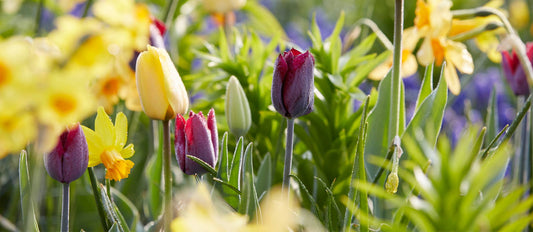Bare-rooted plants are becoming increasingly popular and it's easy to see why. But quite likely you don't know exactly what they are or what to do with them. Let us explain, in this blog!
Bare-rooted plants are plants that only have bare roots. Our growers remove the roots from the soil when the plants are one year old. The plants have already flowered once, which means that they have had a year to grow strong. This way we know for sure that the plant is in good condition. The plants are also sold just like that, with no nursery pot, decorative pot or even packaging. This is actually the way that people traditionally used to sell and plant.
What are the benefits of bare-rooted plants?
Bare-rooted plants have a number of advantages compared to garden plants in a nursery pot:
- As we've already said, the roots are stronger because of the extra year of growth that they have already had in the nursery. From the very first year after planting you will see that the plant's growth is stronger than a plant from a nursery pot.
- Bare rooted plants root much faster. After planting, the roots immediately have good contact with the soil, which is not the case with plants in a nursery pot. Plants in nursery pots first have to make contact with the soil from their root ball, which can mean that it takes longer for the plant to start growing.
- Bare-rooted plants get off to a faster start after planting. Plants in a grower's pot actually stand still in their growth process. This can result in diseases and loss.
- Bare-rooted plants are less sensitive to dry, cold or wet periods than plants in nursery pots. Temperature fluctuations do not affect them much, which is brilliant for growth and the overall health of the plant.
- And last but not least, bare-rooted plants are a lot more sustainable. Not only because their survival is more rapid, but also because they are not delivered in a plastic nursery pot and with a lot of packaging material.
How do you plant bare-rooted plants?
Planting bare-rooted plants is easy. Below you will find a number of planting tips:
- You can plant the roots in flower pots or in the open ground.
- Make sure that the roots always point downwards.
- For an abundant bunch of roots make a hole that is twice the diameter of the roots so that every root has enough space.
- Cover the roots with fresh soil. This contains roughly 60 days of plant food.
- If the root has a branch or a green sprout it is important that this sticks out above the soil.
- If the root consists of just one, large root then be sure that you place it 'nose' up, just below the surface.
- After planting, only water if the soil is dry. It is important that the soil remains a little moist, so if it doesn't rain, water the plant.
- You can fertilise the plants once the growth and flowering period begins. Use organic garden fertiliser or food pellets for both the roots in pots and in the garden.
Bare-rooted plants: it doesn't get much more sustainable than this
Our roots are delivered in bio-based bags. Bio-based bags have lower CO2 emissions because they are made from sugar cane and can be recycled. The bags contain peat. This means that the roots do not have to go into earth straight after they are delivered. The bag can be stored in a cool place and does not need maintenance. Our bare roots are always hardy, perennial plants, so they can stay in the garden all year round.




